Analysis of Hepatic Fibrosis Characteristics in Cirrhotic Patients with and without Hepatocellular Carcinoma by FTIR Spectral Imaging
Abstract
1. Introduction
2. Results and Discussion
2.1. Analysis of Spectral Images of Whole Hepatic Samples Acquired with a Projected Pixel Size of 25 µm
2.2. Analysis of Spectral Images of Fibrosis Tissue Areas Acquired with a Projected Pixel Size of 2.7 µm
3. Materials and Methods
3.1. Selection and Preparation of Samples
3.2. Histological and Digital Analysis
3.3. FTIR Data Collection
3.3.1. Infrared Imaging of Whole Hepatic Samples
3.3.2. FTIR Imaging Focused on Hepatic Fibrosis Tissue
3.4. Spectral Data Preprocessing
3.5. Analysis of Spectral Images of Whole Hepatic Samples
3.6. Analysis of Spectral Images Focused on Fibrosis Areas
3.7. Statistical Analysis
4. Conclusions
Supplementary Materials
Author Contributions
Funding
Acknowledgments
Conflicts of Interest
References
- Anthony, P.P.; Ishak, K.G.; Nayak, N.C.; Poulsen, H.E.; Scheuer, P.J.; Sobin, L.H. The morphology of cirrhosis: Definition, nomenclature, and classification. Bull. World Health Organ. 1977, 55, 521–540. [Google Scholar]
- The French, M.C.S.G. Intraobserver and interobserver variations in liver biopsy interpretation in patients with chronic hepatitis C. Hepatology 1994, 20, 15–20. [Google Scholar]
- Ishak, K.; Baptista, A.; Bianchi, L.; Callea, F.; De Groote, J.; Gudat, F.; Denk, H.; Desmet, V.; Korb, G.; MacSween, R.N.M. Histological grading and staging of chronic hepatitis. J. Hepatol. 1995, 22, 696–699. [Google Scholar] [CrossRef]
- Pellicoro, A.; Ramachandran, P.; Iredale, J.P. Reversibility of liver fibrosis. Fibrogenesis Tissue Repair 2012, 5 (Suppl. 1), S26. [Google Scholar] [CrossRef]
- Kutami, R.; Girgrah, N.; Wanless, I.R.; Sniderman, K.; Wong, F.S.; Sherman, M.; Heathcote, J.; Lilly, L. The Laennec grading system for assessment of hepatic fibrosis: Validation by correlation with wedged hepatic vein pressure and clinical features. Hepatology 2000, 32, 407A. [Google Scholar]
- Wanless, I.R.; Sweeney, G.; Dhillon, A.P.; Guido, M.; Piga, A.; Galanello, R.; Gamberini, M.R.; Schwartz, E.; Cohen, A.R. Lack of progressive hepatic fibrosis during long-term therapy with deferiprone in subjects with transfusion-dependent beta-thalassemia. Blood 2002, 100, 1566–1569. [Google Scholar] [CrossRef]
- Kim, M.Y.; Cho, M.Y.; Baik, S.K.; Park, H.J.; Jeon, H.K.; Im, C.K.; Won, C.S.; Kim, J.W.; Kim, H.S.; Kwon, S.O. Histological subclassification of cirrhosis using the Laennec fibrosis scoring system correlates with clinical stage and grade of portal hypertension. J. Hepatol. 2011, 55, 1004–1009. [Google Scholar] [CrossRef]
- Kim, G.; Lee, S.S.; Baik, S.K.; Cho, Y.Z.; Kim, M.Y.; Kwon, S.O.; Cha, S.H.; Cho, M.Y. The need for histological subclassification of cirrhosis: A systematic review and meta-analysis. Liver Int. 2016, 36, 847–855. [Google Scholar] [CrossRef]
- Kim, S.U.; Oh, H.J.; Wanless, I.R.; Lee, S.; Han, K.-H.; Park, Y.N. The Laennec staging system for histological sub-classification of cirrhosis is useful for stratification of prognosis in patients with liver cirrhosis. J. Hepatol. 2012, 57, 556–563. [Google Scholar] [CrossRef]
- Gressner, A.M.; Weiskirchen, R. Modern pathogenetic concepts of liver fibrosis suggest stellate cells and TGF-beta as major players and therapeutic targets. J. Cell Mol. Med. 2006, 10, 76–99. [Google Scholar] [CrossRef] [PubMed]
- Karsdal, M.A.; Nielsen, S.H.; Leeming, D.J.; Langholm, L.L.; Nielsen, M.J.; Manon-Jensen, T.; Siebuhr, A.; Gudmann, N.S.; Ronnow, S.; Sand, J.M.; et al. The good and the bad collagens of fibrosis-their role in signaling and organ function. Adv. Drug. Deliv. Rev. 2017, 121, 43–56. [Google Scholar] [CrossRef] [PubMed]
- Friedman, S.L. Mechanisms of hepatic fibrogenesis. Gastroenterology 2008, 134, 1655–1669. [Google Scholar] [CrossRef] [PubMed]
- Grenard, P.; Bresson-Hadni, S.; El Alaoui, S.; Chevallier, M.; Vuitton, D.A.; Ricard-Blum, S. Transglutaminase-mediated cross-linking is involved in the stabilization of extracellular matrix in human liver fibrosis. J. Hepatol. 2001, 35, 367–375. [Google Scholar] [CrossRef]
- Ricard-Blum, S.; Baffet, G.; Théret, N. Molecular and tissue alterations of collagens in fibrosis. Matrix Biol. 2018, 68–69, 122–149. [Google Scholar] [CrossRef]
- Baker, M.J.; Trevisan, J.; Bassan, P.; Bhargava, R.; Butler, H.J.; Dorling, K.M.; Fielden, P.R.; Fogarty, S.W.; Fullwood, N.J.; Heys, K.A. Using Fourier transform IR spectroscopy to analyze biological materials. Nat. Protoc. 2014, 9, 1771–1791. [Google Scholar] [CrossRef]
- Belbachir, K.; Noreen, R.; Gouspillou, G.; Petibois, C. Collagen types analysis and differentiation by FTIR spectroscopy. Anal. Bioanal. Chem. 2009, 395, 829–837. [Google Scholar] [CrossRef]
- Petibois, C.; Gouspillou, G.; Wehbe, K.; Delage, J.-P.; Déléris, G. Analysis of type I and IV collagens by FT-IR spectroscopy and imaging for a molecular investigation of skeletal muscle connective tissue. Anal. Bioanal. Chem. 2006, 386, 1961–1966. [Google Scholar] [CrossRef]
- Riaz, T.; Zeeshan, R.; Zarif, F.; Ilyas, K.; Muhammad, N.; Safi, S.Z.; Rahim, A.; Rizvi, S.A.A.; Rehman, I.U. FTIR analysis of natural and synthetic collagen. Appl. Spectrosc. Rev. 2018, 53, 703–746. [Google Scholar] [CrossRef]
- Guilbert, M.; Eklouh-Molinier, C.; Wehbe, K.; Sulé-Suso, J.; Yang, Y.; Cinque, G.; Jeannesson, P.; Sockalingum, G.D. Probing single-tumor cell interactions with different-age type I collagen networks by synchrotron-based Fourier transform infrared microspectroscopy. J. Biomed. Opt. 2014, 19, 111612. [Google Scholar] [CrossRef]
- Guilbert, M.; Said, G.; Happillon, T.; Untereiner, V.; Garnotel, R.; Jeannesson, P.; Sockalingum, G.D. Probing non-enzymatic glycation of type I collagen: A novel approach using Raman and infrared biophotonic methods. Biochim. Biophys. Acta 2013, 1830, 3525–3531. [Google Scholar] [CrossRef]
- Bird, B.; Rowlette, J. A protocol for rapid, label-free histochemical imaging of fibrotic liver. Analyst 2017, 142, 1179–1184. [Google Scholar] [CrossRef]
- Crombie, D.E.; Mackay, I.R.; Wood, B.R.; McNaughton, D.; Rowley, M.J. Hepatobiliary and pancreatic: Liver histopathology: Fourier transform infrared microspectroscopic imaging for objective and quantifiable assessment of liver biopsies. J. Gastroenterol. Hepatol. 2005, 20, 485. [Google Scholar] [CrossRef]
- Le Naour, F.; Sandt, C.; Peng, C.; Trcera, N.; Chiappini, F.; Flank, A.-M.; Guettier, C.; Dumas, P. In situ chemical composition analysis of cirrhosis by combining synchrotron fourier transform infrared and synchrotron X-ray fluorescence microspectroscopies on the same tissue section. Anal. Chem. 2012, 84, 10260–10266. [Google Scholar] [CrossRef]
- Sreedhar, H.; Varma, V.K.; Gambacorta, F.V.; Guzman, G.; Walsh, M.J. Infrared spectroscopic imaging detects chemical modifications in liver fibrosis due to diabetes and disease. Biomed. Opt. Express 2016, 7, 2419–2424. [Google Scholar] [CrossRef]
- Huang, Z.; Liang, B.; Xiong, M.; Dong, K.; Zhang, Z.; Zhang, E.; Li, C.; Chen, X. Severity of cirrhosis should determine the operative modality for patients with early hepatocellular carcinoma and compensated liver function. Surgery 2016, 159, 621–631. [Google Scholar] [CrossRef]
- Kim, S.U.; Jung, K.S.; Lee, S.; Park, J.Y.; Kim, D.Y.; Ahn, S.H.; Choi, G.H.; Kim, K.S.; Choi, J.S.; Han, K. Histological subclassification of cirrhosis can predict recurrence after curative resection of hepatocellular carcinoma. Liver Int. 2014, 34, 1008–1017. [Google Scholar] [CrossRef]
- Tsochatzis, E.; Bruno, S.; Isgro, G.; Hall, A.; Theocharidou, E.; Manousou, P.; Dhillon, A.P.; Burroughs, A.K.; Luong, T.V. Collagen proportionate area is superior to other histological methods for sub-classifying cirrhosis and determining prognosis. J. Hepatol. 2014, 60, 948–954. [Google Scholar] [CrossRef]
- Vuiblet, V.; Fere, M.; Gobinet, C.; Birembaut, P.; Piot, O.; Rieu, P. Renal graft fibrosis and inflammation quantification by an automated Fourier-transform infrared imaging technique. J. Am. Soc. Nephrol. 2016, 27, 2382–2391. [Google Scholar] [CrossRef]
- Huleihel, M.; Salman, A.; Erukhimovitch, V.; Ramesh, J.; Hammody, Z.; Mordechai, S. Novel spectral method for the study of viral carcinogenesis in vitro. J. Biochem. Biophys. Methods 2002, 50, 111–121. [Google Scholar] [CrossRef]
- Mordechai, S.; Mordehai, J.; Ramesh, J.; Levi, C.; Huleihal, M.; Erukhimovitch, V.; Moser, A.; Kapelushnik, J. Application of FTIR microspectroscopy for the follow-up of childhood leukemia chemotherapy. In Proceedings of the Subsurface and Surface Sensing Technologies and Applications III, San Diego, CA, USA, 27 November 2001. [Google Scholar] [CrossRef]
- Wood, B.R.; Quinn, M.A.; Tait, B.; Ashdown, M.; Hislop, T.; Romeo, M.; McNaughton, D. FTIR microspectroscopic study of cell types and potential confounding variables in screening for cervical malignancies. Biospectroscopy 1998, 4, 75–91. [Google Scholar] [CrossRef]
- Chiriboga, L.; Xie, P.; Yee, H.; Vigorita, V.; Zarou, D.; Zakim, D.; Diem, M. Infrared spectroscopy of human tissue. I. Differentiation and maturation of epithelial cells in the human cervix. Biospectroscopy 1998, 4, 47–53. [Google Scholar] [CrossRef]
- Wong, P.T.; Wong, R.K.; Caputo, T.A.; Godwin, T.A.; Rigas, B. Infrared spectroscopy of exfoliated human cervical cells: Evidence of extensive structural changes during carcinogenesis. Proc. Natl. Acad Sci. USA 1991, 88, 10988–10992. [Google Scholar] [CrossRef] [PubMed]
- Fukuyama, Y.; Yoshida, S.; Yanagisawa, S.; Shimizu, M. A study on the differences between oral squamous cell carcinomas and normal oral mucosas measured by Fourier transform infrared spectroscopy. Biospectroscopy 1999, 5, 117–126. [Google Scholar] [CrossRef]
- Eckel, R.; Huo, H.; Guan, H.-W.; Hu, X.; Che, X.; Huang, W.-D. Characteristic infrared spectroscopic patterns in the protein bands of human breast cancer tissue. Vib. Spectrosc. 2001, 27, 165–173. [Google Scholar] [CrossRef]
- Fabian, H.; Wessel, R.; Jackson, M.; Schwartz, A.; Lasch, P.; Fichtner, I.; Mantsch, H.H.; Naumann, D. IR spectroscopy and IR microscopy of human breast tumors, xenografted breast tumors, and breast tumor cell lines. In Proceedings of the Infrared Spectroscopy: New Tool in Medicine, San Jose, CA, USA, 24 April 1998. [Google Scholar] [CrossRef]
- Fujioka, N.; Morimoto, Y.; Arai, T.; Kikuchi, M. Discrimination between normal and malignant human gastric tissues by Fourier transform infrared spectroscopy. Cancer Detect. Prev. 2004, 28, 32–36. [Google Scholar] [CrossRef]
- Fung, M.F.K.; Senterman, M.K.; Mikhael, N.Z.; Lacelle, S.; Wong, P.T.T. Pressure-tuning Fourier transform infrared spectroscopic study of carcinogenesis in human endometrium. Biospectroscopy 1996, 2, 155–165. [Google Scholar] [CrossRef]
- McIntosh, L.M.; Jackson, M.; Mantsch, H.H.; Stranc, M.F.; Pilavdzic, D.; Crowson, A.N. Infrared spectra of basal cell carcinomas are distinct from non-tumor-bearing skin components. J. Invest. Derm. 1999, 112, 951–956. [Google Scholar] [CrossRef]
- Richter, T.; Steiner, G.; Abu-Id, M.H.; Salzer, R.; Bergmann, R.; Rodig, H.; Johannsen, B. Identification of tumor tissue by FTIR spectroscopy in combination with positron emission tomography. Vib. Spectrosc. 2002, 28, 103–110. [Google Scholar] [CrossRef]
- Andrus, P.G.L.; Strickland, R.D. Cancer grading by Fourier transform infrared spectroscopy. Biospectroscopy 1998, 4, 37–46. [Google Scholar] [CrossRef]
- Rigas, B.; Morgello, S.; Goldman, I.S.; Wong, P.T. Human colorectal cancers display abnormal Fourier-transform infrared spectra. Proc. Natl. Acad. Sci. USA 1990, 87, 8140–8144. [Google Scholar] [CrossRef]
- Mittal, S.; Yeh, K.; Leslie, L.S.; Kenkel, S.; Kajdacsy-Balla, A.; Bhargava, R. Simultaneous cancer and tumor microenvironment subtyping using confocal infrared microscopy for all-digital molecular histopathology. Proc. Natl. Acad. Sci. USA 2018, 115, E5651–E5660. [Google Scholar] [CrossRef] [PubMed]
- Ly, E.; Piot, O.; Wolthuis, R.; Durlach, A.; Bernard, P.; Manfait, M. Combination of FTIR spectral imaging and chemometrics for tumour detection from paraffin-embedded biopsies. Analyst 2008, 133, 197–205. [Google Scholar] [CrossRef] [PubMed]
- Wolthuis, R.; Travo, A.; Nicolet, C.; Neuville, A.; Gaub, M.-P.; Guenot, D.; Ly, E.; Manfait, M.; Jeannesson, P.; Piot, O. IR spectral imaging for histopathological characterization of xenografted human colon carcinomas. Anal. Chem. 2008, 80, 8461–8469. [Google Scholar] [CrossRef] [PubMed]
- Jain, A.K.; Dubes, R.C. Algorithms for Clustering Data; Prentice-Hall, Inc.: Upper Saddle River, NJ, USA, 1988. [Google Scholar]
Sample Availability: Samples of the compounds are not available from the authors. |
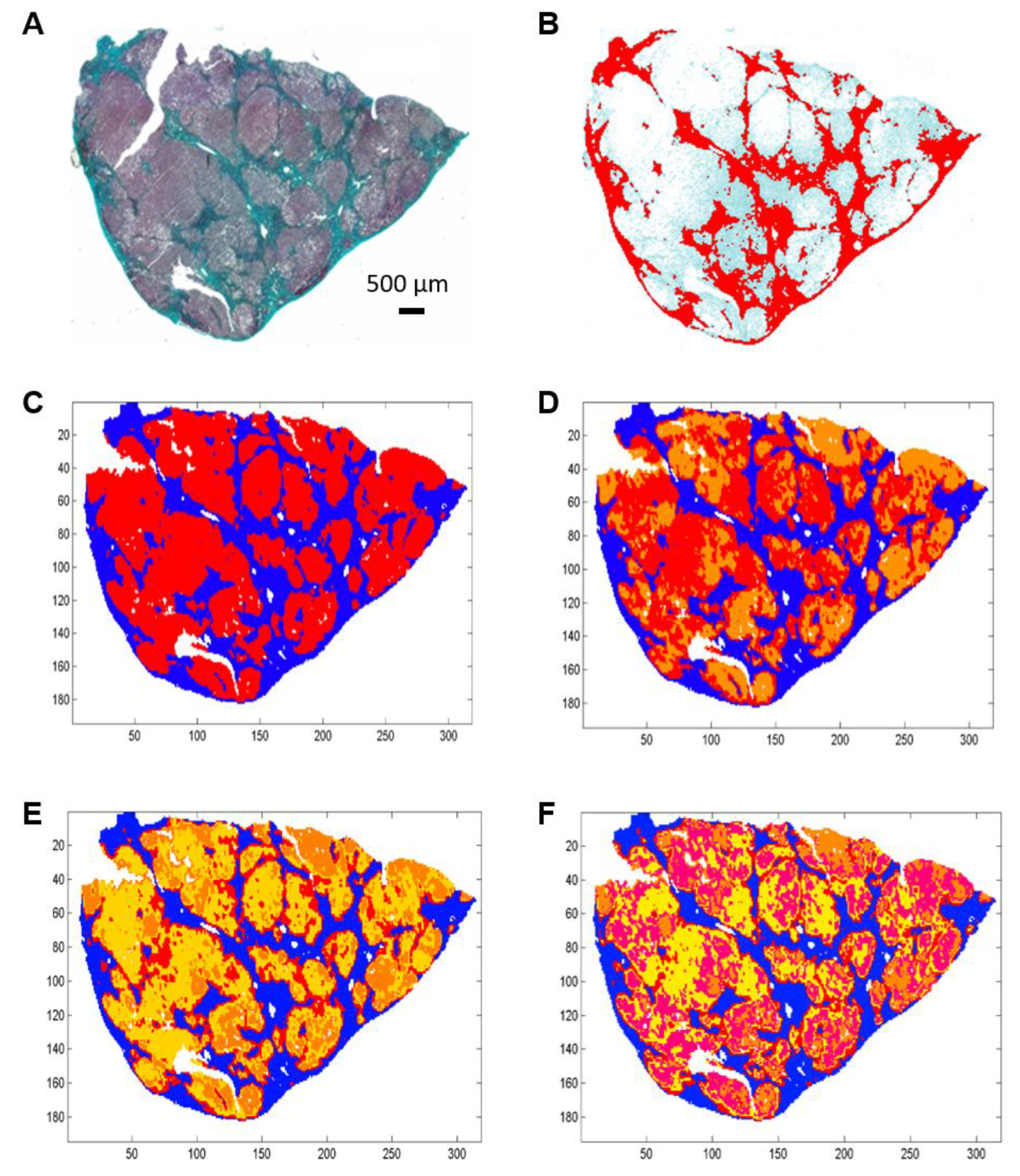
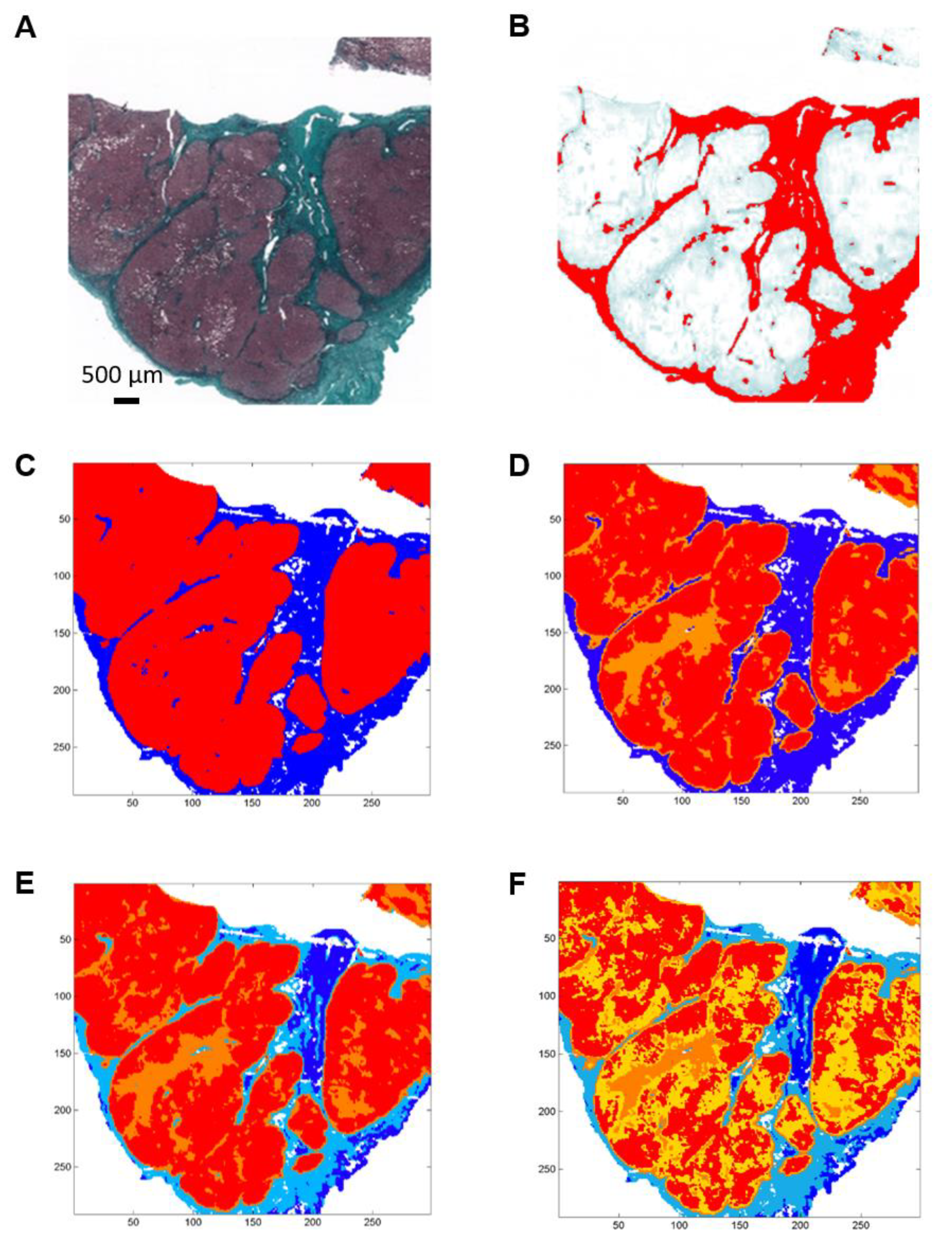
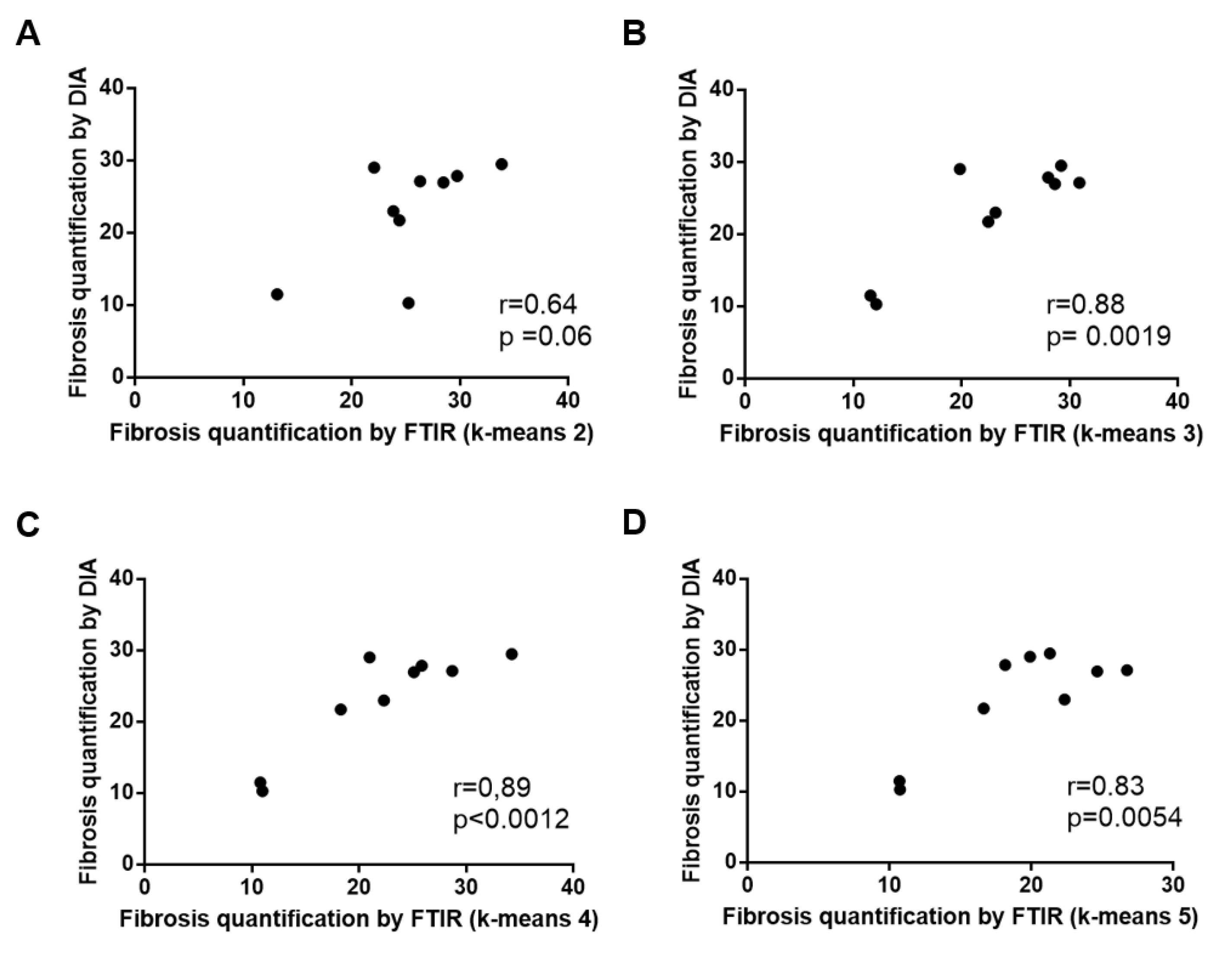


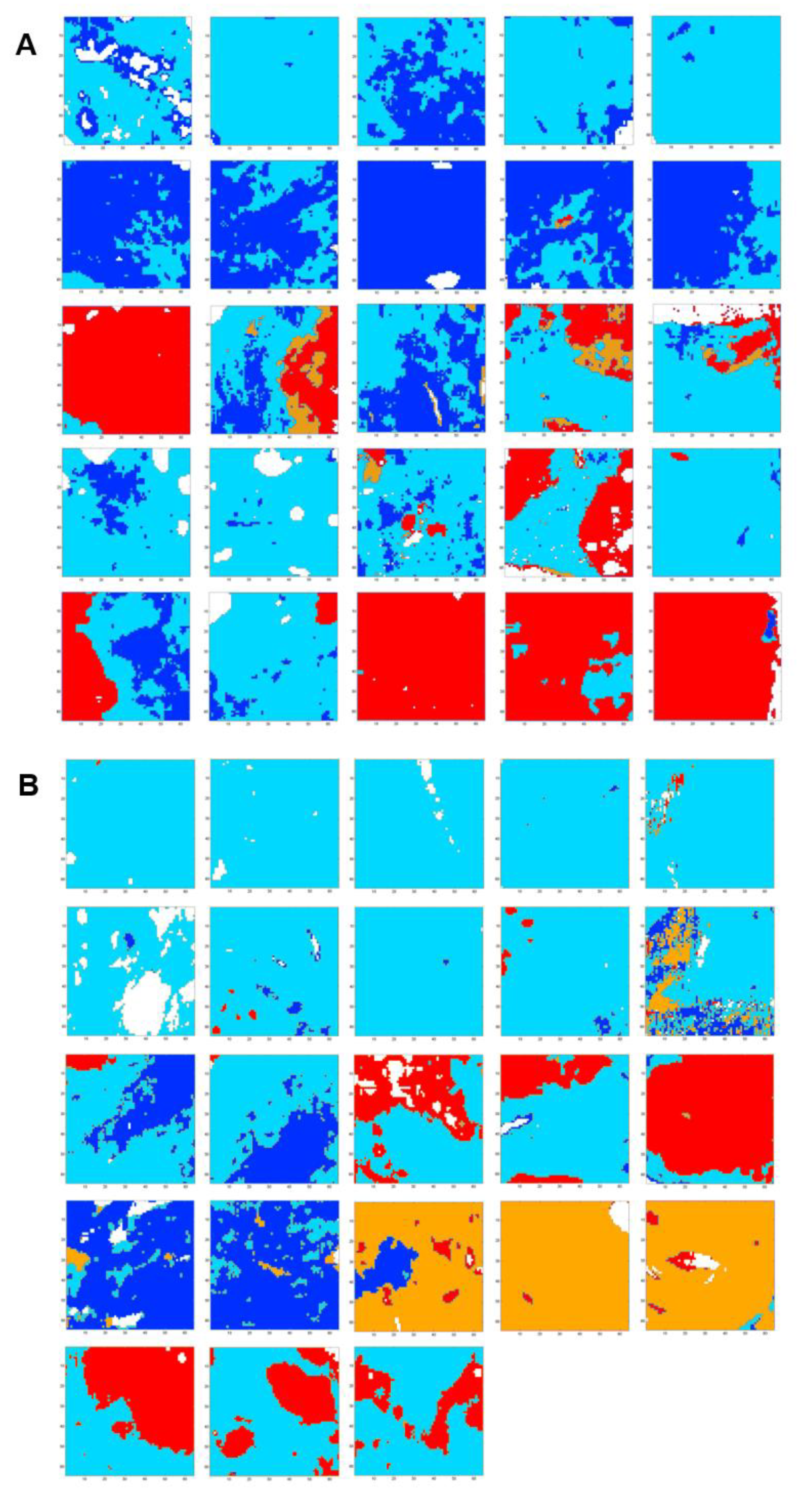
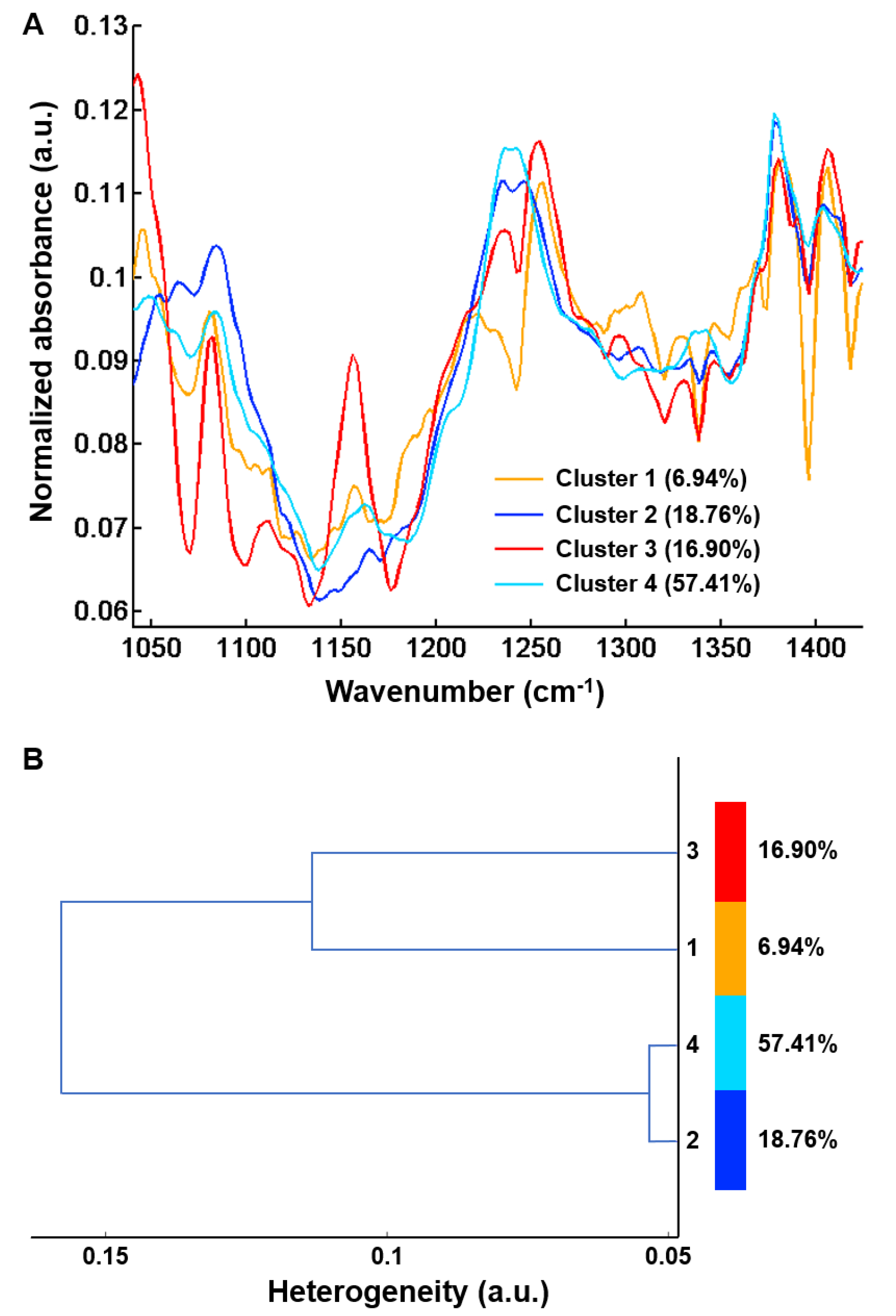

| Fibrosis Areas (% of Total Tissue) | ||
|---|---|---|
| Spectral Classes of Fibrosis | Uncomplicated Cirrhosis | Cirrhosis with HCC |
| Cluster 4 | 69.4% | 83.9% |
| Cluster 2 | 30.6% | 16.1% |
© 2020 by the authors. Licensee MDPI, Basel, Switzerland. This article is an open access article distributed under the terms and conditions of the Creative Commons Attribution (CC BY) license (http://creativecommons.org/licenses/by/4.0/).
Share and Cite
Moreau, J.; Bouzy, P.; Guillard, J.; Untereiner, V.; Garnotel, R.; Marchal, A.; Gobinet, C.; Terryn, C.; Sockalingum, G.D.; Thiéfin, G. Analysis of Hepatic Fibrosis Characteristics in Cirrhotic Patients with and without Hepatocellular Carcinoma by FTIR Spectral Imaging. Molecules 2020, 25, 4092. https://doi.org/10.3390/molecules25184092
Moreau J, Bouzy P, Guillard J, Untereiner V, Garnotel R, Marchal A, Gobinet C, Terryn C, Sockalingum GD, Thiéfin G. Analysis of Hepatic Fibrosis Characteristics in Cirrhotic Patients with and without Hepatocellular Carcinoma by FTIR Spectral Imaging. Molecules. 2020; 25(18):4092. https://doi.org/10.3390/molecules25184092
Chicago/Turabian StyleMoreau, Johanna, Pascaline Bouzy, Julien Guillard, Valérie Untereiner, Roselyne Garnotel, Aude Marchal, Cyril Gobinet, Christine Terryn, Ganesh D. Sockalingum, and Gérard Thiéfin. 2020. "Analysis of Hepatic Fibrosis Characteristics in Cirrhotic Patients with and without Hepatocellular Carcinoma by FTIR Spectral Imaging" Molecules 25, no. 18: 4092. https://doi.org/10.3390/molecules25184092
APA StyleMoreau, J., Bouzy, P., Guillard, J., Untereiner, V., Garnotel, R., Marchal, A., Gobinet, C., Terryn, C., Sockalingum, G. D., & Thiéfin, G. (2020). Analysis of Hepatic Fibrosis Characteristics in Cirrhotic Patients with and without Hepatocellular Carcinoma by FTIR Spectral Imaging. Molecules, 25(18), 4092. https://doi.org/10.3390/molecules25184092









